
Cryptandra amara, commonly known as bitter cryptandra or pretty pearlflower, is a species of flowering plant in the family Rhamnaceae and is endemic to eastern Australia. It is a densely-branched shrub with clustered, more or less linear to egg-shaped or elliptic leaves, and tube-shaped white flowers arranged on the ends of branchlets.

Cryptandra ericoides, commonly known as heathy cryptandra, is a species of flowering plant in the family Rhamnaceae and is endemic to south-eastern continental Australia. It is a wiry, low-lying to erect shrub with often clustered, cylindrical leaves, and tube-shaped white flowers arranged in clusters on the ends of branchlets.
Pomaderris tropica is a species of flowering plant in the family Rhamnaceae and is endemic to Walshs Pyramid in north Queesland. It is a shrub with softly-hairy branchlets, egg-shaped to elliptic leaves and clusters of white to cream-coloured flowers.

Leucopogon cuspidatus is a species of flowering plant in the family Ericaceae and is endemic to the central Queensland coast. It is a shrub with densely hairy young branchlets, egg-shaped to lance-shaped leaves with the narrower end towards the base, and white, bell-shaped flowers that are bearded inside.

Spyridium scortechinii is a species of flowering plant in the family Rhamnaceae and is endemic to eastern Australia. It is a shrub with egg-shaped to narrowly elliptic leaves, and dense heads of white, woolly-hairy flowers with brown bracts at the base.
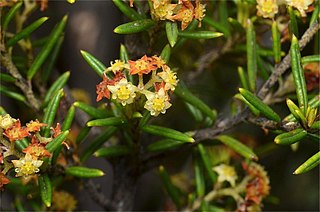
Spyridium daltonii is a species of flowering plant in the family Rhamnaceae and is endemic to Victoria in Australia. It is a shrub with softly-hairy branchlets, linear to narrowly elliptic leaves, and small groups of hairy, yellowish flowers.
Pimelea chlorina is a species of flowering plant in the family Thymelaeaceae and is endemic to north Queensland. It is a shrub with silvery, elliptic or egg-shaped leaves and clusters of greenish-yellow, tube-shaped flowers.
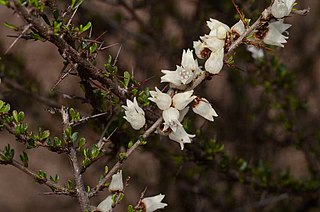
Cryptandra armata is a flowering plant in the family Rhamnaceae and is endemic to Queensland. It is a shrub with spiny branchlets, spatula-shaped to lance-shaped or egg-shaped leaves with the narrower end towards the base, and creamy-white tube-shaped to bell-shaped flowers.
Cryptandra beverleyensis is a species of flowering plant in the family Rhamnaceae and is endemic to the southwest of Western Australia. It is a shrub with narrowly oblong leaves and clusters of white, tube-shaped flowers.
Cryptandra campanulata is a species of flowering plant in the family Rhamnaceae and is endemic to South Australia. It is a shrub with narrowly elliptic to narrowly egg-shaped or linear leaves and clusters of white, bell-shaped flowers.
Cryptandra congesta is a flowering plant in the family Rhamnaceae and is endemic to a restricted area of the south-west of Western Australia. It is a low, spreading shrub with narrowly egg-shaped or narrowly oblong leaves and clusters of white, tube-shaped flowers.

Cryptandra connata is a species of flowering plant in the family Rhamnaceae and is endemic to inland Western Australia. It is an erect, prickly shrub with linear to lance-shaped leaves and clusters of white, pink or purple, tube-shaped flowers.
Cryptandra craigiae is a flowering plant in the family Rhamnaceae and is endemic to a restricted area of southern Western Australia. It is a shrub with linear leaves and dense clusters of white or cream-coloured, tube-shaped flowers.
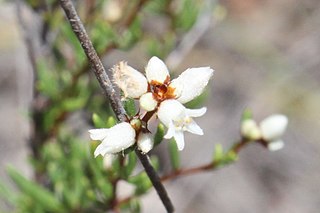
Cryptandra debilis is a species of flowering plant in the family Rhamnaceae and is endemic to north Queensland. It is a small shrub with clustered, linear leaves and densely-hairy, white, tube-shaped flowers.
Cryptandra dielsii is a flowering plant in the family Rhamnaceae and is endemic to the south-west of Western Australia. It is a spreading shrub with linear to narrowly oblong leaves and dense clusters of white, hairy, tube-shaped flowers.
Cryptandra distigma is a flowering plant in the family Rhamnaceae and is endemic to inland Western Australia. It is a shrub with oblong or narrowly egg-shaped leaves and clusters of white to cream-coloured, tube-shaped flowers.
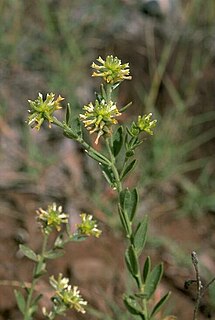
Pimelea confertiflora is a species of flowering plant in the family Thymelaeaceae and is endemic to north Queensland. It is a shrub with densely hairy young stems, elliptic or narrowly elliptic leaves and spikes of yellowish-green or yellow, tube-shaped flowers.
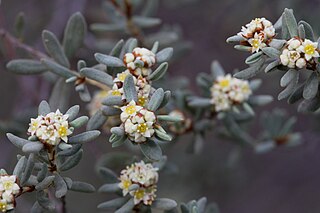
Spyridium subochreatum is a species of flowering plant in the family Rhamnaceae and is endemic to southern continental Australia. It is a low shrub with linear to oblong or narrowly egg-shaped leaves, and dense clusters of creamy-white flowers with dark brown, papery bracts at the base.
Cryptandra exserta is a flowering plant in the family Rhamnaceae and is endemic to inland Western Australia. It is a shrub with narrowly oblong leaves and clusters of white, tube-shaped flowers.
Cryptandra filiformis is a species of flowering plant in the family Rhamnaceae and is endemic to north Queensland. It is a shrub with narrowly elliptic to narrowly lance-shaped leaves and white to creamy-white, tube-shaped flowers.









